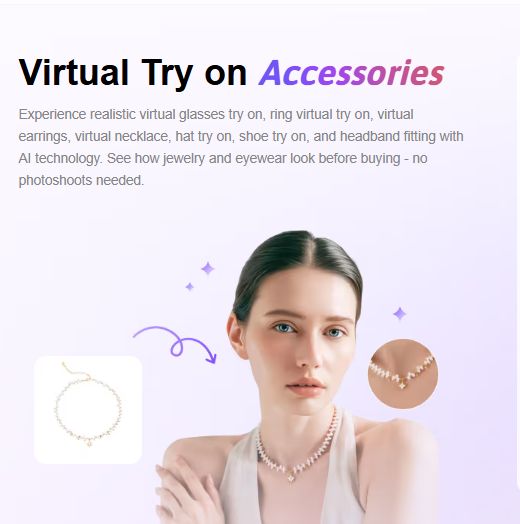The fashion industry has entered a new era where technology directly influences shopping behavior. Virtual try-on accessories are no longer futuristic experiments—they’re essential tools for building consumer trust, driving sales, and creating immersive customer experiences.
In 2025, shoppers demand more than just product images. They want to see how a pair of earrings complements their outfit or whether sunglasses fit their face shape before making a purchase. Seller Pic, an innovative AI-powered platform, provides fashion brands with the ability to integrate virtual accessory previews seamlessly into their e-commerce stores.
This guide explores the benefits, technologies, and strategies behind virtual try-on technology and explains why fashion retailers must adopt it now to remain competitive.
What Is Virtual Try-On for Fashion Accessories?
How AR and AI Drive the Experience
Virtual try-on accessories combine augmented reality shopping with AI image recognition to create a digital fitting room for jewelry, eyewear, hats, and more. By using smartphone cameras or web-based platforms, customers can see real-time overlays of products, achieving a personalized online shopping experience.
The process involves:
- 3D product visualization to ensure accurate proportions and textures.
- AI-powered virtual fitting rooms that adjust accessories to individual facial features.
- Interactive shopping tools for comparing multiple styles instantly.
Why Fashion Brands Can’t Ignore Virtual Try-On
Fashion brands face rising expectations. Customers no longer rely on guesswork—they expect try-before-you-buy online solutions that build confidence. Integrating virtual try-on technology for fashion brands reduces product returns, improves satisfaction, and keeps buyers engaged longer.
Key Benefits of Virtual Try-On Accessories for Fashion Brands
Enhanced Customer Confidence and Engagement
When customers use virtual jewelry try-on or virtual sunglasses try-on apps, they get the confidence of seeing products in action. This strengthens customer buying behavior and creates a stronger emotional connection with the brand.
Reduced Return Rates and Higher Conversions
One of the biggest challenges in e-commerce is high return rates due to sizing or style mismatches. With AI-powered virtual try-on accessories, fashion retailers minimize this problem, ensuring shoppers make informed decisions.
Stronger Brand Identity and Innovation
Implementing digital fashion transformation signals that a brand is forward-thinking. Customers associate fashion e-commerce innovation with reliability, creativity, and leadership.
How Fashion Brands Use Virtual Try-On Accessories
Jewelry Retailers Adopting Digital Previews
From necklaces to rings, virtual jewelry try-on tools allow customers to explore different styles without visiting a store. This convenience reshapes digital consumer experiences.
Sunglasses and Eyewear Try-On Technology
Eyewear retailers are leveraging virtual sunglasses try-on apps for shoppers, offering realistic previews that help customers choose the right frame size and design.
Luxury and Everyday Fashion Integration
From luxury boutiques to everyday accessory stores, virtual fitting experiences are becoming the standard for online shopping innovation.
Best Virtual Try-On Tools for Fashion Brands in 2025
Enterprise-Level Platforms
High-end retailers often invest in advanced AR shopping 2025 solutions that integrate with custom websites and mobile apps.
Affordable Solutions for Small Brands
Independent sellers and small boutiques can rely on platforms like Seller Pic, which provides accessible, AI virtual fitting room technology without requiring heavy investment.
Mobile-Friendly Shopping Experiences
With the rise of mobile shopping apps, fashion brands are embedding virtual accessory previews directly into customer journeys, making adoption seamless.
The Future of Virtual Try-On in Fashion E-Commerce
Trends Defining Online Shopping in 2025
Online shopping trends 2025 show that virtual try-on accessories are no longer optional—they are shaping the way customers interact with fashion brands.
Expanding Into AR and VR Experiences
The combination of virtual reality shopping, 3D product visualization, and smart retail technology will take fashion e-commerce into even more immersive territory.
Consumer Behavior and Personalization
AI-driven e-commerce personalization ensures that shoppers receive recommendations based on preferences, face shape, and past behavior, aligning perfectly with customer engagement tools.
Conclusion – Why Virtual Try-On Is the Future for Fashion Brands
The future of e-commerce is not just about selling products—it’s about selling experiences. Virtual try-on accessories help fashion brands build trust, reduce returns, and create a personalized digital fashion journey for every customer.
With platforms like Seller Pic, even smaller retailers can access powerful AI-powered virtual try-on solutions that enhance brand credibility and keep customers engaged. For fashion brands, adopting this technology in 2025 is no longer a choice—it’s a necessity for survival in a competitive online landscape.
FAQs About Virtual Try-On Accessories for Fashion Brands
What are virtual try-on accessories?
Virtual try-on accessories are AR shopping tools that let customers preview items like jewelry, sunglasses, and hats online before purchase.
How does AI power virtual try-on technology?
AI enables 3D product visualization, detects face shapes, and adjusts digital products in real time for realistic previews.
Why should fashion brands use virtual try-on?
It builds customer confidence, reduces return rates, and creates immersive online shopping experiences.
Is virtual try-on only for large fashion retailers?
No, affordable solutions like Seller Pic make virtual try-on technology available to small and mid-size fashion businesses.
How do virtual sunglasses try-on apps work?
They use augmented reality apps and smartphone cameras to place frames digitally on a shopper’s face.
Does virtual try-on help reduce returns?
Yes, by allowing shoppers to visualize products accurately, virtual fitting experiences significantly reduce sizing and style-related returns.
What accessories can be tried on virtually?
Customers can try jewelry, sunglasses, hats, scarves, and even watches using AI virtual fitting room technology.
Do virtual try-on solutions work on mobile devices?
Yes, most mobile shopping apps now support virtual accessory previews for convenience.
Is the technology difficult to integrate into websites?
Not at all. Platforms like Seller Pic offer plug-ins and APIs that make integration seamless.
What is the future of virtual try-on in fashion e-commerce?
The future is AI-driven and immersive, combining AR, VR, and personalization to deliver next-level shopping experiences.
